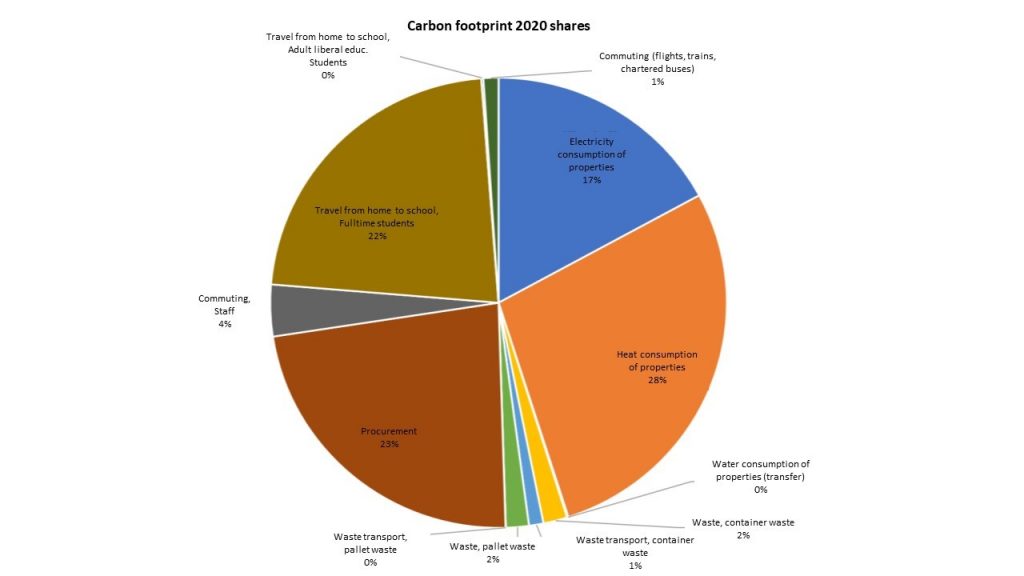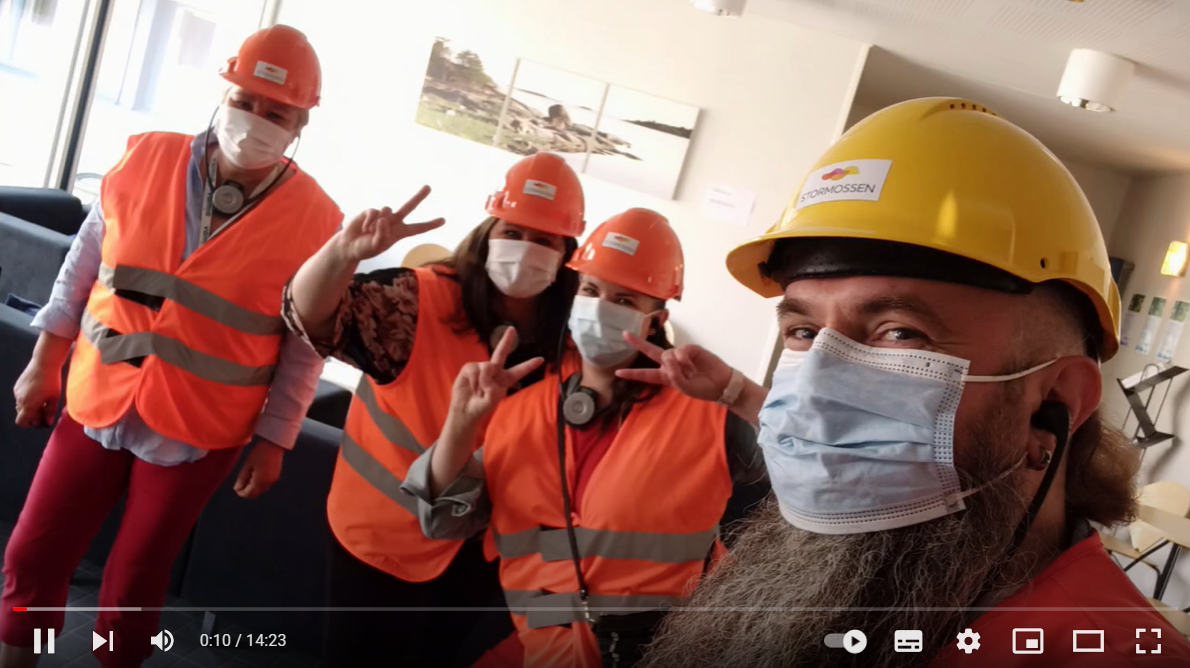
Destination: Carbon neutral Omnia
We are committed to reducing our carbon footprint to guide our choices in procurement, policies and processes. In 2025, Omnia will be carbon neutral and Omnia’s energy self-sufficiency rate will have increased significantly.

Omnia promotes citizens’ participation, skills and well-being and increases the vitality of municipalities, communities and businesses in the region. Omnia is a large and modern education provider offering a wide range of services with a focus on supporting lifelong learning. Our operations are guided by the changing needs of the future.
We offer vocational secondary and upper secondary education, youth workshops, vocational qualifications and liberal adult education courses, as well as training, vocational courses and recruitment support for companies. Omnia has partnerships with 3,000 companies and we are strongly involved in business and trade services in the region.
Omnia’s key sustainability goals are to achieve carbon neutrality by 2025. In order to achieve the goal, one must know the current situation. Therefore, we have calculated Omnia’s carbon footprint for 2020. The calculation is based on the GHG protocol standard.
The aim of the calculation is to find out our largest sources of emissions so that we can focus on the right things to achieve the goal of carbon neutrality. The calculation is to be repeated regularly so that we can monitor the progress of our goal and the effectiveness of the actions taken. On the other hand, the calculation communicates Omnia’s responsibility and environmental goals – we are among the very first vocational schools in Finland to reduce their carbon footprint.
The calculation of Omnia’s carbon footprint is based on the following principles:
- the institution’s own activities (incl. real estate)
- the procurement and supply chain of the educational institution, including distribution logistics
- other factors affecting the amount of carbon dioxide equivalent.
Emissions from properties consist of consumed heat and electricity production and water consumption. In addition, the properties generate waste that is transported for use as material, in energy production or disposed of. In addition, property maintenance and upkeep, as well as related mobility, generate emissions.
The carbon footprint of Omnia’s purchases was calculated on the basis of information received from suppliers of goods and services. The 200 largest suppliers of goods and services were examined in more detail in the calculation, as they were estimated to give a sufficiently broad picture of the products and services consumed by Omnia. Operators considered to be insignificant in terms of carbon footprint, such as e-service providers, were first listed as suppliers. A questionnaire was sent to suppliers to find out, on a supplier-by-supplier basis, all products and services delivered to Omnia in 2020. In addition, the principal was asked about the quantities and methods of transporting the products to the supplier and further to Omnia. The lifecycle carbon footprint values of products or services that suppliers may already have were also examined.
The proportion of student and staff mobility was determined in the calculation using a questionnaire. The survey was used to find out the amounts and ways of moving between the home and the offices. The survey was divided into three categories: staff, full-time students, and liberal adult education students. The survey asked about ways and amounts of movement on a weekly basis, and the results were used to scale the movement of all three groups of people throughout the year. The calculation took into account the share of distance learning and teleworking due to the Covid-19 pandemic, as well as the reduced course offer of the liberal adult education in 2020.
As a result of the calculation, Omnia’s carbon footprint in 2020 is 6757 tonnes of CO2eqv.
Based on the results of the calculation, the electricity and heat consumption of properties makes up the vast majority of Omnia’s carbon footprint.
Commuting also forms a significant part of Omnia’s carbon footprint. By far the largest share is accounted for by full-time student commuter traffic, but emissions from staff commuting are by far the largest in relation to the number of personnel.
As 2020 has been exceptional due to the Covid-19 pandemic, it has been considered appropriate to make a comparison with 2019, which has been considered normal. The amount of waste has fallen below one-fifth, which also does not make a significant difference in the carbon footprint. The total value of purchases in 2020 will be about 15% less, which can be estimated to affect the carbon footprint in roughly the same proportion. The most significant effect in the Corona year in terms of emissions is reduced mobility, as only 57% of contact teaching has taken place. When all these effects are added together, the 2019 carbon footprint can be estimated at 8474 tonnes of CO2eqv. The exceptional operations in 2020 can therefore be estimated to have reduced Omnia’s CO2 emissions by about 20%.
As noted, the electricity and heat consumption of the properties accounts for most of Omnia’s carbon footprint. Therefore, it can be estimated that the choices already made for electricity and district heating sources will significantly reduce Omnia’s carbon footprint. On September 1, 2020, Omnia has switched to using 100% emission-free district heating for the properties it owns. With regard to electricity, the use of 50% green electricity has been switched to 1.1.2021. These measures are therefore in the right direction, but in order to achieve the goal of carbon neutrality, new measures need to be taken and the possibilities for increasing energy self-sufficiency need to be considered.
In terms of commuter traffic, by far the largest share of carbon emissions comes from the commuting of full-time students, but emissions from staff commuting are clearly the largest in relation to the number of people. Regarding commuting, both staff and students should be encouraged to use lower-carbon or zero-emission forms of traffic. For example, measures such as the increase in commuter tickets, business bicycles and various forms of sharing have a reducing effect on the carbon footprint of mobility. A partial continuation of distance learning and remote working practices even after an emergency would also reduce the need for mobility and thus emissions.
The share of procurement has been challenging in the calculation. It is therefore essential to include in the contracts the obligation to declare the origin of the products. This also serves as an excellent message of Omnia’s responsibility to the outside world.

Due to the monitoring and evaluation of the effectiveness of the measures, the calculation of the carbon footprint should be repeated periodically. In order to develop Omnia’s calculation, at least the following measures should be considered for future calculations. The automation of the data collection form would facilitate the operation of the person responsible for the project and the recording of any available data also between calculations. Updating the supplier register and checking the up-to-dateness of the contact information of the contact persons before the next calculation. An audit of major suppliers, which would also serve as an excellent advance preparation for a responsibility report. The commuting survey should be tailored to better take into account the characteristics of the groups. In addition, the distribution channels and response time of the survey could be reconsidered to achieve a more comprehensive set of respondents.
Article by:

Mika Heino
Expert, International Affairs, Omnia, the Joint Authority of Education in Espoo Region
Email: mika.heino@omnia.fi



